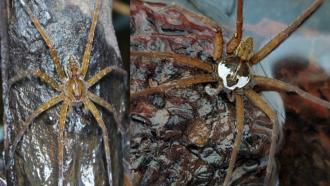
Spider webs are unique — they are ultra-light, yet strong enough to capture a big bee. The silk fibres produced by spiders are tough and elastic, which is why they are used in sensing chemical compounds, promoting wound healing and making optical instruments. They are also biodegradable and harmless to living tissues. Though all spiders produce silk, not all build webs. Some spiders use silk as draglines to commute, build cocoons for nursing eggs and young ones, or to wrap up prey. Spider webs come in all shapes and sizes, with the common ones being spiral orb webs, cobwebs, triangle webs, funnel webs, mesh webs, and sheet webs.
Orb webs are two-dimensional webs woven by several spider families, of which the garden spider is the best example. These webs are composed of several circular threads interspersed with radial filaments. The spider sits at the centre, looking out for prey or predators. It uses vibrations transmitted from various stimuli, such as wind, rain and prey, to identify and orient towards them. Once it finds a trapped victim, the spider approaches and attacks the prey with its venom.
In a study, researchers at the Indian Institute of Technology, Rupnagar, have explored how prey is caught and retained by a healthy spider web when compared with a damaged one. The study, published in the journal Philosophical Transactions of the Royal Society A, was featured under the theme 'Bioinspired materials and surfaces for green science and technology'. The researchers studied the webs of St Andrew's Cross spider (Argiope aetherea), which builds orb-webs and belongs to the Araneidae family.
A spider's web may be damaged during prey capture or its escape, or due to light, temperature, wind and rain. Some spiders eat their webs, damaging it in the process. The researchers studied the structural properties of spider webs by looking at the differences in vibrations produced by them. In general, orb-webs generate two types of waves — transverse and longitudinal. The transverse vibrations propagate along the spiral threads of the web, whereas the longitudinal vibrations move along the radial threads.
The researchers measured the variations in the stiffness or rigidity, transmissibility and damping in the web due to vibrations. The stiffness affects the web's structural properties, and the transmissibility determines the transmission of waves and responses. Damping refers to the reduction in the amplitude of vibrations as their energy decreases.
The web's stiffness and damping properties depend on how it is built and influence prey capture. For example, spiral threads have sticky spots along their length, which trap and hold the prey until the spider arrives to attack. They also support the web as they are stretchable and help prey capture. The major ampulla, a gland in spiders involved in the formation of silk, determines the material properties of these spiral threads. The radial threads, on the other hand, are larger in diameter, stiffer, stronger and more elastic. They are essential for dissipation of kinetic energy of the prey within the web.
When a prey strikes the spiral threads, the tension in the adjacent threads increases, resulting in the oscillation of the web. The study found that the transmission time of the resulting vibrations depends on this tension. When the spider sits at the centre, the tension in the radial threads increases due to the weight. This increase changes the length of the web, increasing the transmission time. The probability of prey capture is higher if the mass of the web is greater.
The researchers also observed that spider webs could be reconstructed based on environmental conditions and the extent of the damage. When the area of damage was significant, reconstruction was difficult for the spider, reducing its ability to capture the prey. However, minor damages did not impact the web's prey capture and retention properties. While damaged spiral threads resulted in that part of the web being isolated, broken radial threads increased the transmission time. A partially damaged web also had lower stiffness, transmission time, and damping ratio.
The study shows the resilience of spider webs and how partial damage does not affect its working. With the science behind the structure of spider webs inspiring other fields, these findings could add to the knowledge of versatility of the webs of wonder.






